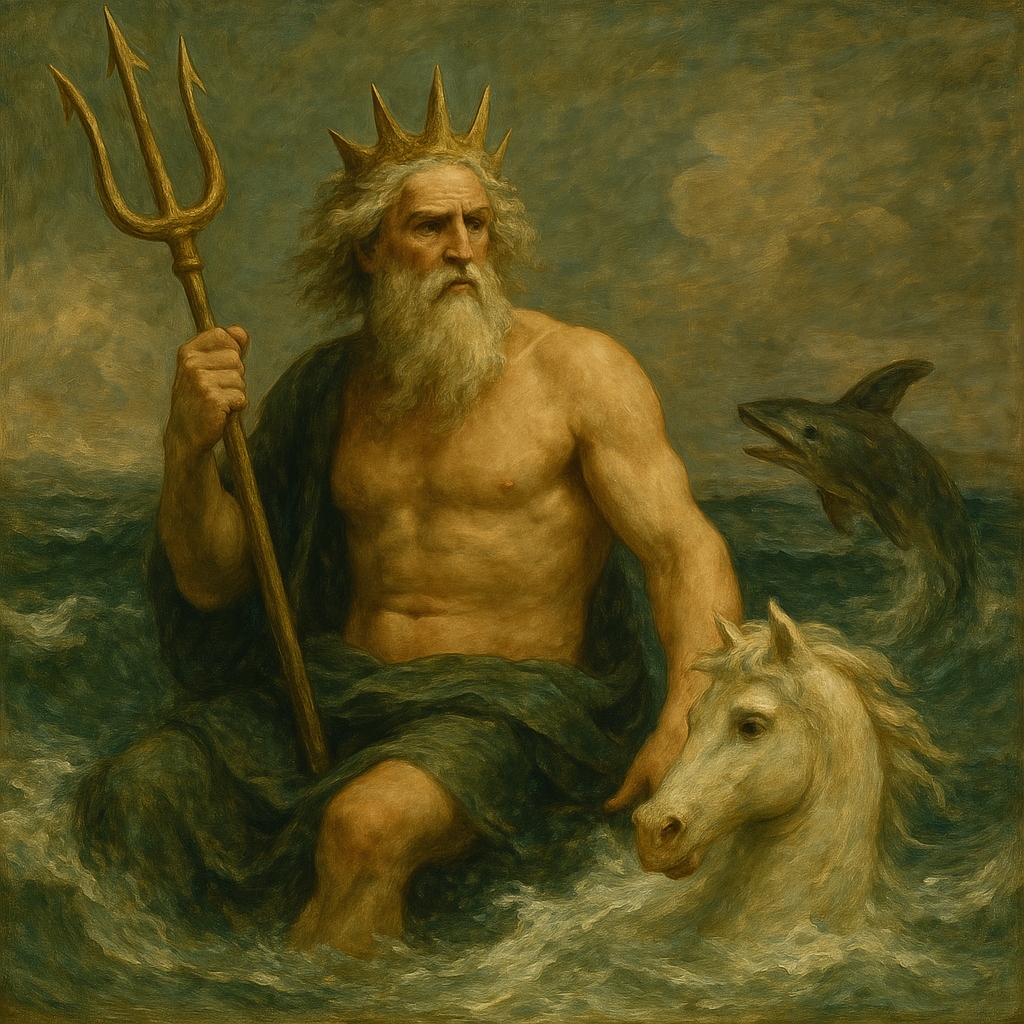Overview
Poseidon, known to the Romans as Neptune, is the ancient Greek god of the sea, earthquakes, storms, and horses. As one of the three principal Olympian brothers—alongside Zeus (sky) and Hades (underworld)—Poseidon rules over all waters, from oceans and rivers to springs and subterranean tides. He is a powerful and often tempestuous deity, associated with both the life-giving and destructive aspects of nature. Mariners, fishermen, and coastal cities sought his favor for safe passage and bounty, while earthquakes and floods were often seen as signs of his anger.
Origins and Mythological Role
Poseidon is the son of Cronus and Rhea, swallowed at birth and later freed by his brother Zeus. After the fall of the Titans, the three brothers divided the cosmos:
- Zeus received the sky,
- Poseidon the sea,
- Hades the underworld.
Poseidon is a primal, elemental force, often unpredictable, deeply emotional, and capable of great generosity or wrath. While he resides in a grand underwater palace in the depths of the sea, he frequently interacts with both gods and mortals, playing key roles in numerous myths and heroic sagas.
Symbols and Iconography
Poseidon is typically depicted as a strong, bearded man, wielding his iconic trident and emerging from or standing within the ocean.
Common Symbols
- Trident – His three-pronged spear, used to stir seas, summon storms, or strike the earth to create springs or earthquakes
- Horse – A sacred animal he created, symbolizing power, freedom, and sea foam
- Dolphin – Representing harmony with marine life and divine guidance at sea
- Bull – Signifying virility, strength, and ancient sea deities
- Tritons and Sea Creatures – Often shown surrounded by Tritons, nereids, or hippocamps (half-horse, half-fish beings)
His iconography emphasizes immense physical power, oceanic majesty, and primal authority.
Attributes and Powers
1. God of the Sea
Poseidon governs the waters of the earth, both tranquil and tumultuous. He controls tides, waves, and the behavior of all sea creatures. Sailors and islanders often prayed to Poseidon for protection, while his anger could unleash shipwrecks, storms, or droughts.
2. Earthshaker (God of Earthquakes)
One of Poseidon’s epithets is “Ennosigaios” or “Earth-Shaker”. With a strike of his trident, he could shake the land, open chasms, or raise new islands. Earthquakes were viewed as signs of his presence or displeasure.
3. Creator of Horses
According to myth, Poseidon created the first horse, either as a gift or in pursuit of the goddess Demeter. He is patron of horse racing, chariot-driving, and all equestrian pursuits. The horse’s connection to waves and speed made it a fitting symbol of his dominion.
4. Force of Male Vitality and Passion
Poseidon is associated with virility, fertility, and desire. His many liaisons, both consensual and forceful, produced a range of powerful offspring, including Theseus, Polyphemus (the Cyclops), Pegasus, and Triton.
5. Guardian of Boundaries and Coastal Cities
He was especially venerated in maritime city-states like Corinth and Athens, offering both protection and punishment. Poseidon was invoked in matters of trade, seafaring, and boundary disputes.
Key Myths and Stories
The Contest for Athens
Poseidon and Athena competed to become the patron of Athens. Poseidon struck the ground with his trident, producing a saltwater spring (or a horse). Athena offered the olive tree, symbolizing peace and prosperity. The people chose Athena’s gift, and Poseidon resented the city, leading to occasional strife.
Poseidon and Odysseus
In Homer’s Odyssey, Poseidon is the main antagonist of Odysseus, punishing him for blinding his son, the Cyclops Polyphemus. Poseidon’s wrath delays Odysseus’s return home by years, demonstrating his immense power over the seas and fates of mortals.
Creation of the Horse
To impress or seduce Demeter, Poseidon created the first horse, emerging from sea foam. This tale links his creative impulse with both wild nature and divine artistry.
Temples and Worship
Major Cult Centers
- Cape Sounion (near Athens) – Home to a magnificent Temple of Poseidon, overlooking the sea
- Isthmus of Corinth – An important site for worship and horse races
- Helike – An ancient city that worshiped Poseidon as its chief deity and was destroyed by an earthquake and tsunami—believed to be divine retribution
Rituals and Offerings
- Sacrifices of bulls, stallions, and sea creatures
- Libations poured into the sea
- Horse races and nautical games held in his honor
- Appeasement rituals before long sea journeys
Poseidon’s worship often emphasized respect for his unpredictable moods and gratitude for his blessings.
Spiritual and Archetypal Significance
In modern psychological, archetypal, and spiritual frameworks, Poseidon represents:
- The Oceanic Archetype – Depth, emotion, unconscious forces, and the ebb and flow of life
- The Wild Masculine – Strength, passion, primal power, and the tension between force and sensitivity
- The Creator-Destroyer – Capable of bringing forth life and beauty while also unleashing chaos
- Symbol of Movement and Power – Embodying the transformative forces of nature, intuition, and adaptability
He is a powerful guide for:
- Embracing emotional depth and intuitive wisdom
- Navigating personal storms and inner turbulence
- Tapping into physical and creative vitality
- Honoring nature’s power and the sacred wild
Conclusion
Poseidon, god of the sea and Earth-Shaker, embodies the awesome power of nature—its beauty, danger, and life-giving force. He teaches respect for the deep and mysterious currents of the world and the soul, reminding us that both chaos and creation emerge from the same depths. As the ruler of waters and horses, storms and fertility, Poseidon continues to inspire awe as a symbol of raw elemental strength, emotional intensity, and the sacred power of the untamed.

